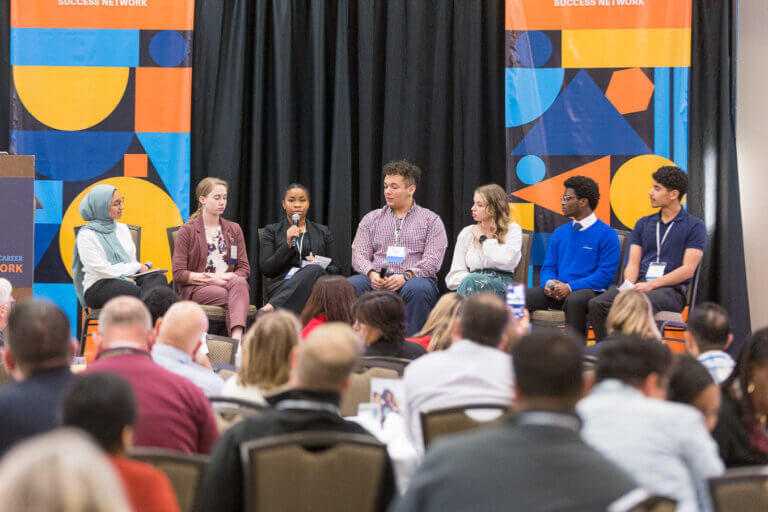In today’s educational landscape, meaningful work-based learning opportunities are essential for equipping young people with real-world skills, confidence, and clarity about their future careers. Given their importance, returning members of the Illinois Education and Career Success Network’s Student Advisory Council participated in a work-based learning workshop in fall 2024.
Six student leaders representing communities across the state participated in a four-part process:
- Through the workshop, students were introduced to work-based learning opportunities across the continuum.
- Students reflected on the work-based learning activities available at their school and potential barriers to engaging in them.
- Following the workshop, students met with a teacher, administrator, or counselor at their school to increase their understanding of work-based learning opportunities and discuss how to address the identified barriers.
- To share their knowledge, students were asked to find a creative way to communicate work-based learning opportunities with their peers.
This article will provide a glimpse of students’ perspectives on work-based learning opportunities at their schools, their barriers, and how conversations with counselors and administrators helped address those challenges.
Access and Barriers to Work-Based Learning Opportunities
When asked about existing work-based learning activities at their schools, not all students were initially aware of the opportunities available to them. While some students had a broad understanding of what was offered, many were unaware of the different programs or resources until they actively sought out information. Despite this, almost every student knew who to approach—whether it was a career counselor, teacher, or administrator—when they wanted to learn more about available opportunities. Interestingly, the most commonly recognized work-based learning activity among students, even before speaking to a school representative, was internships, suggesting that this form of professional learning might be the most familiar or widely discussed within their school communities.
All of the student leaders identified lack of awareness as the most common barrier when asked, “What barriers are preventing you or your peers from engaging in existing work-based learning activities at your school?”
“My school offers a lot of resources, but a lack of knowledge on these resources is a barrier.”
“The lack of knowledge is a barrier because we don’t hear much about it at school.”
“My school doesn’t really tell the students about a lot of these things so you’ll have to figure it out on your own. So better communication will be helpful for my peers.”
“We offer a lot but students just don’t know enough. Our district admin is trying, but there is a disconnect between students and staff.”
“Better communication and spread of knowledge, especially to the student population. Because lots of students want things to occupy their time after school.”
Student Advisors in Action: Collaborating with Teachers, Administrators, and Counselors to Address Barriers
Most students had a positive experience when speaking with someone at their school about work-based learning opportunities and barriers. Some gained valuable access to these opportunities through supportive staff, while others overcame obstacles by persistently advocating for change and creating new pathways for their peers:
“I discussed work-based learning with my school’s career resource specialist. We have many career-based clubs, such as FBLA, HOSA, and FCCLA. We have a senior survey in which students can reflect on what they want to know more about. Our school has a school career connection section on their website, and students could reach out if they were interested in part-time jobs, job shadowing, internships, research, volunteering, etc.”
– Qi Zhang
“When I spoke with my counselor about work-based learning…most of the activities she spoke about I had already known about. The only reason I never knew that these activities were work-based learning activities was because the school never labeled them as work-based learning activities. Aside from that, the entire conversation was a good experience for me.”
– Samuel Matura
“Over the past year I have been working with our curriculum director for our school and having many conversations with him about CTE barriers. It has been a really great experience, and we have made lots of progress discovering what the student and staff side is to help implement work-based learning in our school. We have begun providing small pathways to increasing work-based learning in my school and starting to understand the barriers in our school and how to change them.”
– Rowan Smith
“I approached my school teacher to discuss my interest in exploring work-based learning opportunities further. I explained my desire to find a work-based learning placement that aligned with my aspirations in medicine and health sciences. [My teacher] was incredibly supportive, providing me with an interview with local health organizations. He also advised me on how to craft a compelling resume and cover letter and offered to conduct a mock interview before my actual interview date.”
– Anasia Beckham
Students Address Barriers by Sharing Resources with Their Peers
To wrap up this process, the Student Advisory Council members took action to help their peers increase awareness of the available opportunities. The following link contains the creative ways students shared the work-based learning opportunities they discovered at their schools: From Learning to Leading: Students Supporting Each Other with College and Career Readiness Resources.
The student leaders engaged in a transformative process where their efforts to understand barriers and explore opportunities not only helped them overcome challenges but also created lasting change, alleviating barriers for others and breaking them down one student at a time. By listening to student voices and empowering students to share their experiences, their ability to create meaningful change is amplified, fostering a cycle of empowerment where students empower other students.


